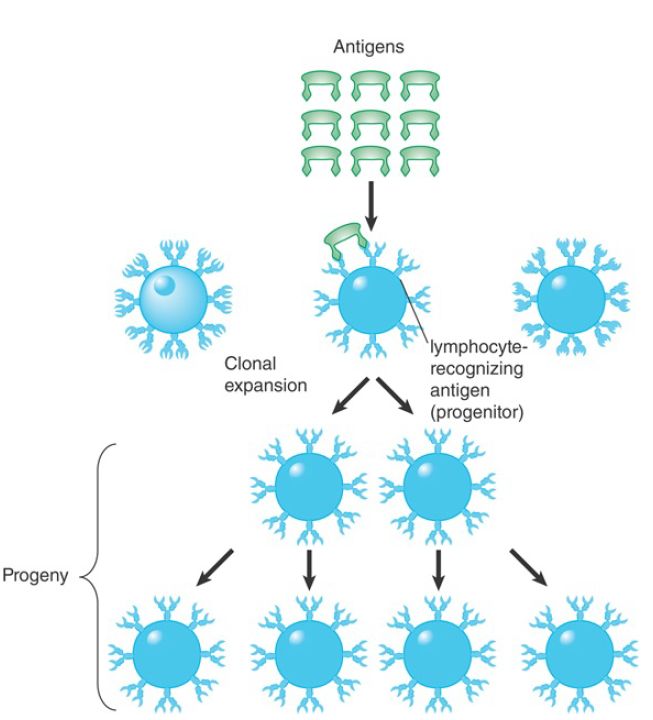
Clonal Selection Amplifies Lymphocytes That Respond to a Given Antigen
 المؤلف:
JOCELYN E. KREBS, ELLIOTT S. GOLDSTEIN and STEPHEN T. KILPATRICK
المؤلف:
JOCELYN E. KREBS, ELLIOTT S. GOLDSTEIN and STEPHEN T. KILPATRICK
 المصدر:
LEWIN’S GENES XII
المصدر:
LEWIN’S GENES XII
 الجزء والصفحة:
الجزء والصفحة:
 28-4-2021
28-4-2021
 2294
2294
Clonal Selection Amplifies Lymphocytes That Respond to a Given Antigen
KEY CONCEPTS
- Each B cell expresses a unique BCR, and each T cell expresses a unique TCR.
- A broad repertoire of BCRs/antibodies and TCRs exists at any time in an organism.
- The antigen binding to a BCR or TCR triggers the clonal proliferation of that receptor-bearing B or T cell.
After an organism has been exposed to an antigen, such as one on an infectious agent, it becomes generally immune to infection by the same agent. Before exposure to a particular antigen, the organism lacks adequate capacity to deal with any toxic effects mediated by or associated with that agent. This ability is acquired through the induction of a specific immune response. After an infection has been defeated, the organism retains the ability to respond rapidly in the event of a reinfection by the same microorganism.
The dynamic distribution of B and T lymphocytes maximizes their chances to encounter their target antigens. Lymphocytes are peripatetic cells. They develop from immature stem cells in the adult bone marrow. They migrate via the bloodstream to the peripheral lymphoid tissues, such as the spleen, lymph nodes, Peyer’s patches, and tonsils. Lymphocytes recirculate between blood and lymph throughout the body, thereby ensuring that an antigen will be exposed to lymphocytes of all possible specificities.
Under appropriate conditions, when a lymphocyte encounters an antigen that binds its BCR or TCR, a specific immune response can be elicited. This is brought about by clonal selection and clonal amplification (FIGURE 1). The repertoire of B and T lymphocytes comprises a large variety of BCRs or TCRs. Any individual B lymphocyte expresses one given BCR, which is capable of recognizing specifically only a single antigen; likewise, any individual T lymphocyte expresses only one given TCR. In the lymphocyte repertoire, unstimulated B cells and T cells are morphologically indistinguishable. Upon exposure to antigen, though, a B cell whose BCR is able to bind the antigen, or a T cell whose TCR can recognize it, is activated and induced to divide, by signaling from the surface of the cell through the BCR/TCR and associated signaling molecules. The induced cell then undergoes rigorous proliferation and morphological changes, including an increase in cell size, and differentiation into an antibody-producing cell or effector T cell. The initial expansion of a specific B or T cell upon first exposure to antigen underlies the primary immune response, leading to the production of large numbers of B or T lymphocytes with specificity for the target antigen. Each population represents a clone of the original responding cell. Selected B cellssecrete larg e quantities of antibodies, and they may even come to dominate the antibody response.

FIGURE 1. The B cell and T cell repertoires include BCRs and TCRs with a variety of specificities. Encounter with an antigen leads to clonal expansion of the lymphocyte with the BCR or TCR that can recognize the antigen.
After a successful primary immune response has been mounted and the challenging antigen cleared, the organism retains the selected B and T cell clones expressing the BCRs and TCRs that are specific for the antigen that induced the response. These memory cells respond promptly and vigorously with clonal expansion upon encounter with the same antigen that induced their differentiation, leading to a secondary (or memory or anamnestic) immune response. Thus, both memory B and T cells are critical elements in the specific resistance to infections after first exposure to a microbial pathogen or vaccine.
The repertoire of B lymphocytes in a mammal comprises more than 1012 specificities (i.e., clones). The T cell repertoire is less expansive. Some clones are poorly represented; that is, they consist of a few cells each, as the corresponding antigen had never been encountered before. Others consist of as many as to 106 cells, because clonal selection has selected and expanded the progeny of lymphocyte in response to a specific antigen. Naturally occurring antigens are in general relatively large molecules and efficient immunogens, inducing an effective immune response.
Small molecules may identify antigenic determinants and can be recognized by antibodies, although owing to their small size they are not effective in inducing an immune response. They do, however, induce a response when conjugated with a larger carrier molecule, usually a protein, such as ovalbumin (OVA), keyhole limpet hemocyanin (KLH), or chicken gamma globulin (CGG). A small molecule that is not immunogenic per se but that can elicit a specific response upon conjugation with a carrier is defined as a hapten. Haptens conjugated with protein carriers generally induce T-dependent antibody responses. T-independent immunizations can be induced by dextran, Ficoll, lipopolysaccharides, or biodegradable nanoparticles. Only a small part of the surface of a macromolecular antigen is actually recognized by any one antibody.
The binding site consists of only five or six amino acids. Any given protein may have more than one such binding site, in which case it induces antibodies with specificities for different sites. The site or region inducing a response is called an antigenic determinant or epitope. In an antigen containing several epitopes, some epitopes may be more effective than others in inducing a specific immune response. In fact, they may be so effective that they dominate the
response, in that they are the targets of all specifically elicited antibodies and/or effector T cells.
 الاكثر قراءة في مواضيع عامة في الاحياء الجزيئي
الاكثر قراءة في مواضيع عامة في الاحياء الجزيئي
 اخر الاخبار
اخر الاخبار
اخبار العتبة العباسية المقدسة


